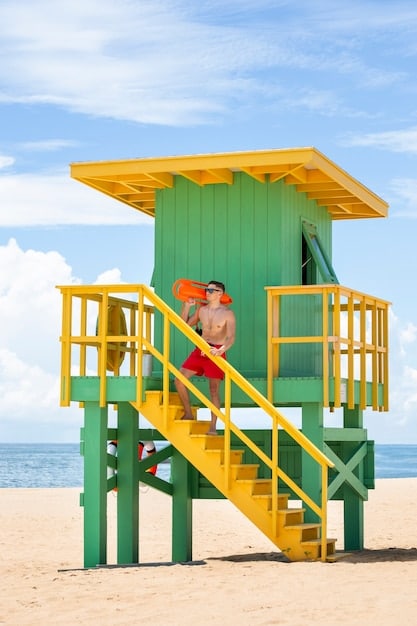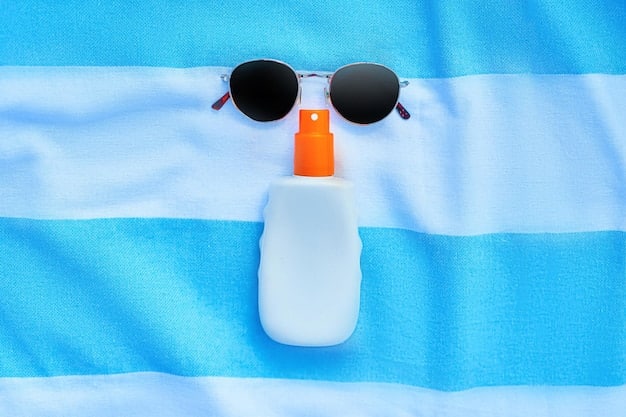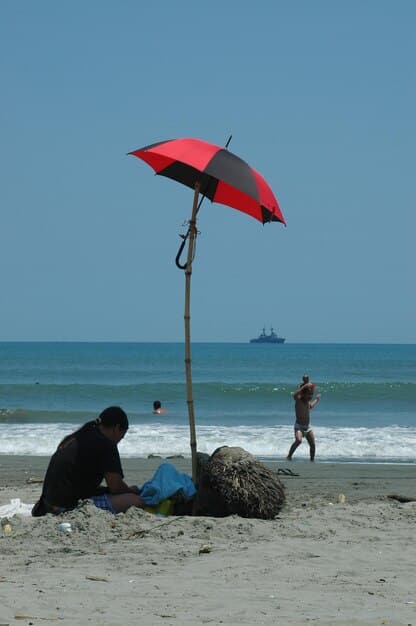How to Choose the Perfect Beach Umbrella: A 2025 Guide

Choosing the perfect beach umbrella for 2025 involves considering size, material, UV protection, wind resistance, and portability to ensure comfortable and safe shade during your beach trips.
Planning a beach trip in 2025? Don’t forget the essentials, and topping that list is a reliable beach umbrella. This **How to Choose the Perfect Beach Umbrella: A 2025 Buyer’s Guide** will walk you through everything you need to consider to stay cool and protected under the sun.
Understanding Your Beach Umbrella Needs
Before diving into the specifics, it’s crucial to assess your personal needs. The right beach umbrella isn’t just about shade; it’s about comfort, convenience, and protection tailored to your beach habits.
Who’s Using the Umbrella?
Consider who will be seeking refuge under the umbrella. A solo traveler might prioritize portability, while a family needs ample shade and stability.
How Often Do You Go to the Beach?
Frequent beachgoers should invest in a durable, high-quality umbrella, whereas occasional visitors might opt for a more budget-friendly model.
- Solo Travelers: Lightweight and easy to carry options are ideal.
- Families: Look for larger umbrellas with increased stability.
- Occasional Visitors: A basic, affordable umbrella should suffice.
Think about these factors to ensure you select a beach umbrella that perfectly matches your lifestyle. Choosing wisely will lead to more enjoyable beach days.
Key Features to Consider in 2025
As we look to 2025, beach umbrella technology and design continue to evolve. Understanding the key features will empower you to make an informed decision.
Size and Coverage
The size of your beach umbrella directly impacts how much shade it provides. Consider the area you need to cover, especially if you’re traveling with family or friends.
UV Protection
UV protection is paramount. Look for umbrellas with a UPF (Ultraviolet Protection Factor) rating of 50+ to block out harmful rays.

- Diameter Matters: Larger diameters offer more shade.
- UPF Rating: Prioritize high UPF ratings for optimal sun protection.
- Fabric Quality: Tightly woven fabrics enhance UV blockage.
Evaluating these features will help you select an umbrella that delivers the shade and protection you need, keeping you safe and comfortable on sunny beach days.
Material Matters: Choosing the Right Fabric and Frame
The materials used in a beach umbrella’s construction greatly influence its durability, weight, and overall performance. Let’s explore the core components and their implications.
Umbrella Fabric: What to Look For
The canopy fabric should be durable, water-resistant, and offer high UV protection. Common materials include polyester, canvas, and specialized UV-resistant fabrics.
Frame Materials: Aluminum vs. Steel vs. Fiberglass
The frame provides the umbrella’s structure and stability. Aluminum is lightweight and rust-resistant, steel is strong but heavier, and fiberglass offers flexibility and wind resistance.
- Polyester: A budget-friendly option that balances durability and cost.
- Canvas: A more premium choice known for its strength and longevity.
- Fiberglass Frames: Excellent for windy conditions due to their flexibility.
Focusing on the materials ensures that your umbrella is not only comfortable but also built to withstand the elements, offering long-term value and satisfaction.
Wind Resistance and Stability Features
A beach umbrella’s ability to withstand wind is a critical factor, especially on breezy days. Look for features that enhance stability and prevent blow-aways.
Ventilation and Wind Vents
Vents at the top of the umbrella canopy allow wind to pass through, reducing pressure and minimizing the risk of the umbrella lifting or flipping.
Tilt Mechanisms and Anchor Systems
Tilt mechanisms let you adjust the umbrella angle to block the sun as it moves, while effective anchor systems keep the umbrella securely planted in the sand.

- Multiple Vents: These enhance airflow and reduce wind impact.
- Sand Anchors: Securely roots the umbrella in the sand.
- Heavy-Duty Poles: Provides a strong, stable base.
Prioritizing wind resistance and stability features ensures that your beach umbrella remains a reliable source of shade, even when the weather turns blustery.
Portability and Ease of Use
An ideal beach umbrella should be easy to transport and set up. Consider features that enhance convenience and reduce hassle.
Weight and Carrying Cases
Lightweight umbrellas are easier to carry, especially over long distances. Look for models that come with carrying cases for convenient storage and transport.
Easy Setup and Take Down Mechanisms
Umbrellas with simple, intuitive setup mechanisms make beach days more enjoyable. Avoid models that require complicated assembly.
- Collapsible Designs: Easy to fold down and pack away.
- Lightweight Materials: Reduces carrying strain.
- Shoulder Straps: Frees up your hands for other essentials.
Considering portability and ease of use makes your beach setup quicker and more convenient, allowing you to relax and enjoy your time by the sea without unnecessary stress.
Top Beach Umbrella Recommendations for 2025
Based on the key features and considerations above, here are a few beach umbrella models that stand out as top contenders for 2025.
Premium Pick: The Deluxe UV Protection Umbrella
This umbrella features high-quality canvas fabric, a robust fiberglass frame, and excellent wind resistance. It’s ideal for those seeking maximum protection and durability.
Budget-Friendly Choice: The Lightweight Portable Umbrella
Offering great UV protection at an affordable price, this umbrella is perfect for occasional beachgoers. Its lightweight design ensures easy portability.
- Deluxe UV Protection Umbrella: Best for frequent beachgoers wanting premium features.
- Lightweight Portable Umbrella: A fantastic option for those on a budget.
These recommendations offer options for different needs and budgets, ensuring that everyone can find the perfect beach umbrella for a fantastic beach experience in 2025.
| Key Feature | Brief Description |
|---|---|
| ☀️ UV Protection | Umbrellas with UPF 50+ block harmful UV rays. |
| 💨 Wind Resistance | Vents and sturdy frames prevent blow-aways. |
| 🧳 Portability | Lightweight models with carrying cases are easier. |
| ⛱️ Size & Coverage | Larger diameters provide more shade for groups. |
Frequently Asked Questions
▼
The ideal UPF rating is 50+, as it blocks 98% of UV rays, providing excellent protection from the sun’s harmful effects during your beach outing.
▼
Wind resistance is crucial; an umbrella with vents and a sturdy frame prevents it from blowing away or breaking in strong winds, ensuring safety and comfort.
▼
Durable umbrellas often feature polyester or canvas canopies and fiberglass or aluminum frames, balancing longevity, UV protection, and resistance to weather elements effectively.
▼
Use sand anchors, heavy-duty poles, or fillable sandbags to firmly secure the umbrella, increasing stability, and preventing it from tipping over or being carried away by the wind.
▼
For a family, opt for a beach umbrella with a diameter of at least 7-8 feet. This provides ample shade and ensures everyone stays protected from the sun.
Conclusion
Choosing the perfect beach umbrella for 2025 involves careful consideration of size, UV protection, wind resistance, material, and portability. By weighing these factors and understanding your specific needs, you can select an umbrella that enhances your beach experience, providing comfortable and safe shade all summer long.





